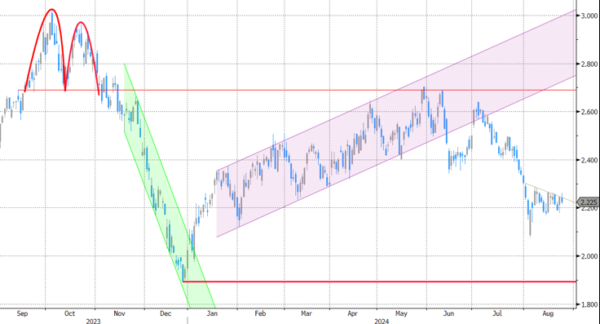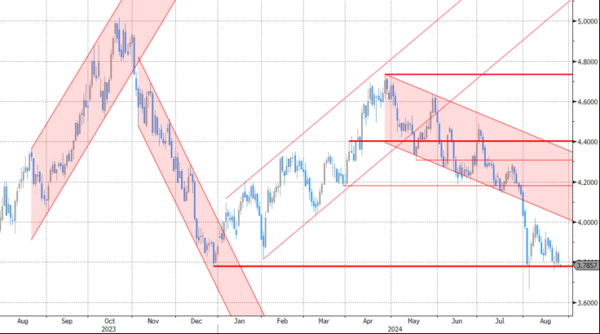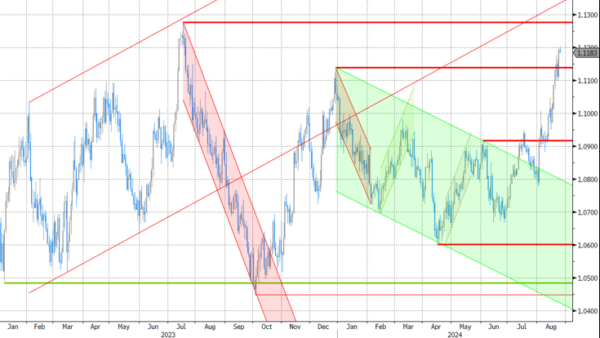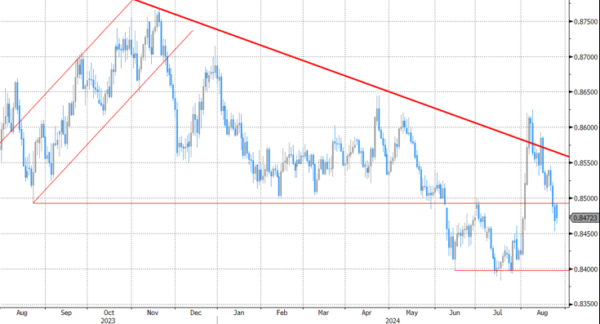Markets
At its keynote Jackson Hole speech on Friday, Fed Chair Powell explicitly reconfirmed the change in the Fed’s assessment on the balance between fighting inflation and preserving maximum employment it already signaled at the July policy meeting. ‘The upside risks to inflation have diminished. And the downside risks to employment have increased.’ The Fed’s confidence that inflation is on a sustainable path to 2.0% is growing. The labor market has cooled considerably from its formerly overheated state. Even as the rise in unemployment mainly comes from a rise in labour supply rather from layoffs, the Fed doesn’t seek or welcome a further cooling of the labour market. With respect to the potential pace of easing Powell stated that while keeping a data-dependent approach. ‘The current level of our policy rate gives us ample room to respond to any risks we may face, including the risk of unwelcome further weakening in labor market conditions.’ With this kind of remarks, Powell left all options open but didn’t formally challenge the market view that the Fed might move to 50 bps steps in a not that distant future. US yields on Friday closed between 8.8 bps (2-y) and 3.5 bps (30-y) lower. Markets now see more than 100 bps of cumulative rate cuts before the end of this year, with the low of the cycle seen near 3.0% (end 2025/early 2026). Despite Friday’s decline, US bond yields didn’t break recent (intraday) lows and are holding above the lows from the early August risk-off move. Still, the picture for the 2-y yield remains fragile. German yields declined between 2.5 bps (5-y) and 0.5 bps (30-y). The direction of travel for the dollar remains clear: south. DXY closed at a 100.72 (from 101.46). EUR/USD tested the 1.12 big figure (close 1.1192). Equity investors embraced the prospect of further, Fed-led easing of (global) financial conditions. US indices gained op to 1.47% (Nasdaq). The S&P 500 (+1.15%) closed less than 1.0% below its all-time peak. The Eurostoxx 50 added 0.5%.
Today’s calendar is modestly interesting with US durable goods orders and German Ifo confidence. US activity data are gaining importance as the Fed is putting less weight on inflation, but the durables’ series is very volatile. Even so, we look out whether the decline in US yields might slow as quite some easing is already discounted. German Ifo confidence is expected to confirm weakness in other recent data evidence. For German/EMU bond markets, inflation to be published on Thursday (Germany) and Friday (EMU), probably are more important. For now, we don’t fight the broader USD downtrend as long markets maintain the view that the Fed can move to 50 bps steps in a not that distant future. Key USD support kicks in at DXY 99.58 and EUR/USD 1.1276 (2023 top).
News & Views
Bank of England governor Bailey said that policy settings will need to remain restrictive for sufficiently long until the risks to inflation remaining sustainably around the 2% target in the medium term have dissipated further. “The course will therefore be a steady one.” The UK central bank chief is nevertheless becoming more confident that things are heading in the right direction. Second round inflation effects appear to be smaller than the BoE expected. They are revising down their assessment on how persistent these pressures would be, though don’t take it for granted yet. Bailey gave no guidance for the outcome of the next, September, policy meeting. UK money markets attach a 25% chance to back-to-back rate cuts with the more likely scenario being that the BoE only implements a next 25 bps rate cut in November, when the new quarterly Monetary Policy Report will be released. Sterling continues outperforming both EUR and USD with cable (GBP/USD), breaching 1.32 for the first time since Q1 2022.
Brazil central bank governor Campos Neto warned at the Kansas City Fed’s Jackson Hole conference that the country’s tight labour market is challenging the central bank’s bid to rein in inflation. Consumer prices have been picking up across Latin America with Brazilian inflation hitting the 4.5% Y/Y ceiling of the tolerance range (3% +- 1.5 ppt) in July. With economic activity picking up, Campos Neto warned that the central bank’s data dependency could result in an higher policy rate if needed. The Brazilian central bank raised its policy rate from 2% in 2021 to a 13.75% peak by mid-2022. They started a gradual easing cycle in mid-2023, but paused it in June at a 10.50% policy rate. arlier this month, influential board member Galipolo who is rumoured to succeed Campos Neto when his term ends in December, indicated that a rate hike is on the table at the next (September) policy meeting.
Graphs
GE 10y yield
The ECB cut policy rates by 25 bps in June. Stubborn inflation (core, services) make follow-up moves less evident. Markets nevertheless price in two to three more cuts for 2024 as disappointing US and unconvincing EMU activity data rolled in, dragging the long end of the curve down. The move accelerated during the early August market meltdown.
US 10y yield
The Fed in its July meeting paved the way for a first cut in September. It turned attentive to risks to the both sides of its dual mandate as the economy is moving to a better in to balance. Markets tend to err in favour of a 50 bps lift-off. The pivot weakened the technical picture in US yields with another batch of weak eco data pushing the 10-yr sub 4%. Powell at Jackson Hole didn’t challenge markets’ positioning.
EUR/USD
EUR/USD moved above the 1.09 resistance area as the dollar lost interest rate support at stealth pace. US recession risks and bets on fast and large (50 bps) rate cuts trumped traditional safe haven flows into USD. EUR/USD 1 1.1276 (2023 top) serves as next technical reference.
EUR/GBP
The BoE delivered a hawkish cut in August. Policy restrictiveness will be further unwound gradually on a pace determined by a broad range of data. The strategy similar to the ECB’s balances out EUR/GBP in a monetary perspective. Risk-off proved a more important driver of GBP recently, triggering a brief return from 0.84 towards 0.86.
















